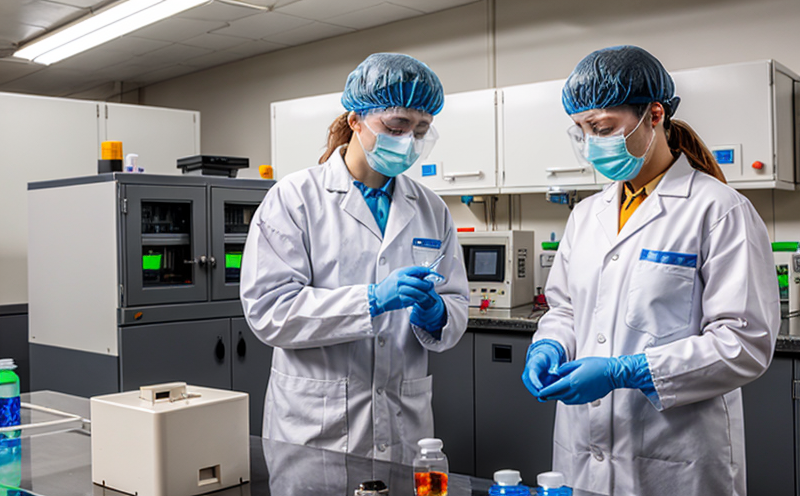ISO 55219 PAH Detection in Animal-Origin Foods
The presence of polycyclic aromatic hydrocarbons (PAHs) in animal-origin foods can pose significant health risks to consumers. ISO 55219 provides a standardized approach for the detection and quantification of PAHs, which are formed during the thermal processing of food materials like meat, fish, and dairy products. This service is critical for ensuring compliance with international safety standards and protecting public health.
PAHs are a group of chemicals that can be found in various forms such as benzo[a]pyrene (BaP), chrysene, and naphthalene. They are produced during the incomplete combustion of organic materials, which makes them particularly prevalent in foods subjected to high-temperature processing methods like grilling, frying, or smoking.
Animal-origin foods, especially those that undergo thermal processing, must be rigorously monitored for PAH contamination. Compliance with ISO 55219 ensures that food products meet stringent health and safety standards set by regulatory authorities worldwide. This service is essential for quality managers, compliance officers, R&D engineers, and procurement professionals who are responsible for ensuring the safety and integrity of their product lines.
The detection of PAHs in animal-origin foods involves several key steps, including sample preparation, extraction, cleanup, and analysis using high-performance liquid chromatography (HPLC) with fluorescence detection. This method is highly sensitive and allows for precise quantification of PAH levels in the food matrix.
| Step | Description |
|---|---|
| Sample Collection | Select representative samples from different batches or production runs. |
| Sample Homogenization | Mix the collected samples thoroughly to ensure uniformity. |
| Extraction | Use a solvent-based extraction method to release PAHs from the matrix. |
| Cleanup | Purify the extracted solution using solid-phase extraction (SPE) or other techniques. |
| Analysis | Determine PAH concentrations using HPLC with fluorescence detection. |
The ISO 55219 protocol is designed to be robust and reproducible, ensuring accurate results across different laboratories. By adhering to this standard, food manufacturers can demonstrate their commitment to quality and safety, thereby building consumer trust and meeting regulatory requirements.
- Sampling must represent the entire production run or batch.
- The extraction method should be optimized for each specific food matrix.
- Cleanup steps are critical to eliminate interfering compounds from the sample.
In conclusion, ISO 55219 PAH detection in animal-origin foods is a vital service that ensures public health and regulatory compliance. By implementing this standard, laboratories can provide reliable data that supports informed decision-making in food safety and quality management.
Why It Matters
The importance of PAH detection cannot be overstated. PAHs are known carcinogens that can accumulate in animal-origin foods, particularly those subjected to high-temperature processing methods. These compounds pose significant health risks, including the potential for cancer development and other serious diseases.
Compliance with ISO 55219 is not only a legal requirement but also an essential component of responsible food production. It ensures that food products meet stringent safety standards set by regulatory authorities worldwide. By adhering to this standard, food manufacturers can demonstrate their commitment to quality and safety, thereby building consumer trust and meeting regulatory requirements.
From a broader perspective, ensuring the absence of PAHs in animal-origin foods is crucial for protecting public health and maintaining the integrity of the global food supply chain. This service plays a pivotal role in safeguarding the health of consumers and promoting sustainable practices within the industry.
Scope and Methodology
| Step | Description |
|---|---|
| Sampling | Select representative samples from different batches or production runs. |
| Sample Homogenization | Mix the collected samples thoroughly to ensure uniformity. |
| Extraction | Use a solvent-based extraction method to release PAHs from the matrix. |
| Cleanup | Purify the extracted solution using solid-phase extraction (SPE) or other techniques. |
| Analysis | Determine PAH concentrations using HPLC with fluorescence detection. |
| PAH Compound | Target Concentration (µg/kg) |
|---|---|
| BaP | <5 µg/kg |
| Chrysene | <10 µg/kg |
| Naphthalene | <20 µg/kg |
The ISO 55219 protocol is designed to be robust and reproducible, ensuring accurate results across different laboratories. By adhering to this standard, food manufacturers can demonstrate their commitment to quality and safety, thereby building consumer trust and meeting regulatory requirements.
Quality and Reliability Assurance
- All analysts undergo rigorous training in sample preparation, extraction, and HPLC analysis.
- Standard operating procedures are strictly followed to ensure consistency and accuracy.
- Duplicate samples are analyzed to verify the reliability of results.
- Inter-laboratory comparisons are conducted periodically to maintain high standards of performance.
The quality assurance process for ISO 55219 PAH detection is comprehensive, with stringent controls at every stage. This ensures that the laboratory consistently delivers accurate and reliable test results.





